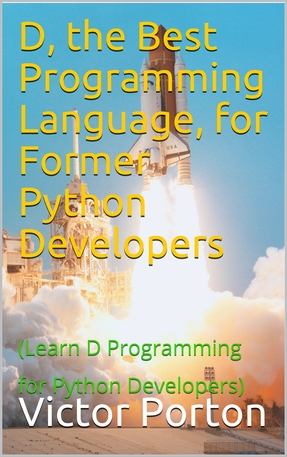Should Python Programmers Switch to D?
- March 28, 2024
- user
- 0
For Python developers, the hunt for the “best” programming language can be a constant murmur. While some believe the concept of a single “best” language is a myth, author Victor Porton’s book, “D, the Best Programming Language, for Former Python Developers,” makes a compelling case for D as a superior alternative, particularly for those seeking speed, reliability, and efficiency. So, if you are looking for the best book to learn Python, you may want to read this blog to the very end. Let’s begin.
Who is Victor Porton?
Victor Porton is the person who discovered ordered semigroup actions (and wrote 500 pages about them), a theory as general as group theory but unknown before.
He is a programming languages polyglot, author of multitudinous softwares and programming libraries, blockchain expert and winner of multitudinous blockchain hackathons, author of several books, and a philosopher.
His book “D, the Best Programming Language, for Former Python Developers” presents the case for D as the alternative language for programmers looking for utmost efficiency, reliability, and speed.
Let’s Address Python’s Limitations.
The book positions D as an antidote to the “nervous mode” of Python development, where developers grapple with potential bugs arising from dynamic programming in Python.
Porton argues that D’s multiparadigm nature offers a calmer environment with increased reliability. This is achieved through features like static typing, which helps catch errors early in the development process.
Performance Boost.
One of the most enticing aspects of D for Python programmers is its potential for significant performance gains. The book presents the case for D programs as hundreds of times faster and less resource-hungry compared to Python. This boost in speed and efficiency can be a game-changer for developers working on demanding applications.
Learning Curve – It’s Easier Than You Think.
The book dispels the myth that D is only for programming geniuses. Author Victor Porton assures readers that the transition from Python to D is manageable due to D’s syntax, which, according to him, is “as easy as Python.” This is likely due to some syntactic similarities between the two languages.
Content Structure and Learning Philosophy.
“D, the Best Programming Language, for Former Python Developers” starts by establishing a clear comparison between D and Python.
Following this introductory section, Porton talks about the core elements of D, building from the basics like data types, variables, and functions, all the way up to advanced features like object-oriented programming, templates, and operator overloading.
The book goes beyond mere syntax by offering guidance on writing clean and effective D code. It also introduces essential libraries, including the Phobos standard library and other valuable third-party options. These libraries equip D programmers with functionalities like asynchronous programming, multithreading, and dependency injection.
Real-World Applications.
Author Victor Porton doesn’t stop at theory. The book includes intriguing articles with titles like “How to Make Your Programs Run Hundreds to Thousands Times Faster Without Giving up Reliability and Ease of Programming” and the thought-provoking “What would be my choice of programming language if I was ordered to write a nuclear weapon control system?”
The latter highlights D’s potential for high-reliability applications, placing it as the second-best choice after Rust for such critical systems. Beyond the basics, the book concludes with practical advice on choosing a D compiler, ensuring a smooth development experience.
Who Should Read This Book?

“D, the Best Programming Language, for Former Python Developers” is a valuable resource for a wide range of programmers:
- Startups and Established Businesses – For companies seeking to improve efficiency and effectiveness, D’s speed and reliability can be a significant advantage.
- Academics and Hobbyists – The book caters to both those exploring new languages for academic pursuits and hobbyists seeking to expand their programming skills.
- Open Source Developers – D’s open-source nature and focus on community make it a compelling choice for those contributing to open-source projects.
- Programmers in Specific Fields – The book highlights D’s applicability in various domains, including electronics, game development, system programming, and even supercomputing.
Programmers looking for an environmentally friendly language will find D’s low electricity consumption appealing, making it a sustainable choice for the future.
Overall, “D, the Best Programming Language, for Former Python Developers” offers a compelling introduction to D, presenting it as a viable alternative for Python programmers seeking a language that prioritizes speed, reliability, and efficiency.
While the book doesn’t claim D as the absolute “best” language, it makes a strong case for its strengths, particularly for those already comfortable with the Python syntax. So, instead of searching for a python programming PDF, we invite you to check out this book. You can buy the book from Amazon . By purchasing this book, you support carbon accounting and DeSci (decentralized science).